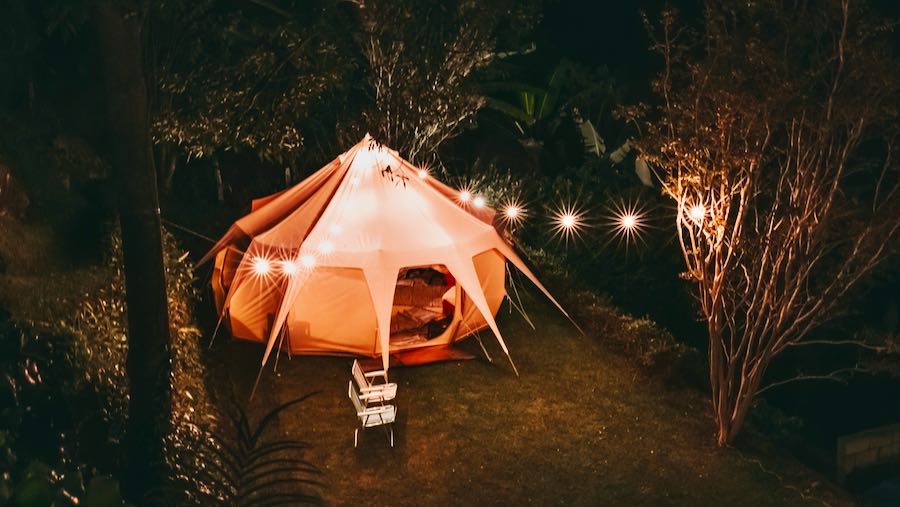I’m going to help you find the best camping canopy. I know the pain of flimsy canopies that tear, disintegrate, blow away, or leave you drenched when the going gets tough. Don’t blow a lid over canopy tops that fail you. I’ll show you how to pick highly rated camping canopies that give you shelter from both storms and buyer’s regret!
In this article, we’re going to review the following canopy tent models:
- EVER ADVANCED Pop Up Gazebo Screen House Tent
- Caddis Rapid Shelter 10′ x 10′
- REI Co-op Screen House Shelter
- Wenzel Magnetic Screen House
- MSR Rendezvous Sun Shield 200 Wing Shelter
- Coleman Instant Canopy
- CAMPROS Screen House Room
- Neso Grande Sunshade
- CLAM Corporation 9879 Quick-Set Escape Shelter
- Yaheetech 10×10 Pop up Canopy Tent
Your Buyer’s Guide to Finding the Best Canopy for Camping
How do you find a camping canopy you can count on? The trouble is that there are so many flimsy canopies out there. It really comes down to knowing about the features and parts that signal a canopy’s durability. Let me walk you through the categories to focus on to avoid a canopy catastrophe.
Why Is a Canopy Helpful When Camping?
The truth is that plenty of people camp without canopies. However, most don’t know what they’re missing. A canopy just adds that “home away from home” vibe that makes a campsite so much more welcoming and wholesome. You’ll find that the canopy becomes the default place for conversation and bonding.
Of course, canopies aren’t just about luxury. Canopies are highly practical. They can also extend the time you can spend enjoying yourself outside of your tent.
What Makes a Good Camping Canopy?
This is really the big question. If you’re shopping for a camping canopy for the first time, you may be wondering about the features that are going to “make the living easy” while you’re enjoying the outdoors. You may even be feeling inspired to look for your first camping canopy because you’ve admired other campers as they enjoyed leisure time under their shady, protective canopies.
Of course, this may not be your first rodeo with camping canopies. You may be wondering how to find a good camping canopy after being disappointed by flimsy canopies in the past. Here are the big problems I see all too frequently when people don’t do their homework on canopies before making a buying choice:
- No water protection.
- No sun protection.
- Poles that bend or break.
- “Superficial” screens that don’t keep bugs out.
- Flimsy mesh that rips easily.
- Entryways that are too tight to fit through comfortably.
- Bulky designs that aren’t portable.
- Designs that are too low.
- Designs that don’t have enough room for the number of campers.
- Complicated instructions that require a whole crew for assembly.
How do you avoid these traps? The thing about camping canopies is that the proof is really in the pudding. It’s almost impossible to know how a canopy is going to perform in your specific camping conditions until you actually use one in real life. However, there are some features and qualities to look for that really help you to avoid disappointment in many cases. That’s what I’m going to get into next.
Features to Look for When Buying a Camping Canopy
The truth is that there’s no one-size-fits-all list of what to look for in camping canopies that’s going to satisfy everyone looking for shelter. The simple reason is that we all buy canopies for different reasons. Someone who is shopping for a canopy that will keep bugs out is looking for completely different features than someone who wants a canopy they can use as a cover for a campsite “kitchen area.”
I’ll do my best to cover as wide a range as possible when it comes to the desirable features to look for in a camping canopy. Not all of the features are going to apply to your specific camping needs. However, I do think that getting a grasp on all of the different possibilities for features and considerations when shopping for camping canopies is going to help you make an informed decision with every camping possibility in mind.
Water Resistance
This is often a must-have feature for campers looking for canopies. It can also be one of the trickiest features to look for when shopping. The tricky part is caused by the fact that many camping canopies have open-aired designs by default. That means that half of the canopy products out there are going to let at least some moisture get into your protected area.
If you’re looking for classic sun shelters without sides, expect driving rain to make its way into your space. However, the roof of a canopy should still offer water resistance to prevent downward deluges over your head. Canopies with covered sides can offer some pretty impressive rain resistance that essentially leaves you dry.
The trick to getting that good water resistance is to look for canopies with panels filled in with durable, rainproof mesh. While you’ll often pay a premium for this feature, the truth is that springing for a high-quality canopy that offers genuine rain resistance is the better option if you’re buying the canopy to be able to enjoy the fresh air when it’s drizzling outside.
I think that having a waterproof canopy really enhances the camping experience exponentially. Nothing is worse than feeling like you have to cram into your tent whenever it starts raining during a camping trip. This one investment enhances your enjoyment by allowing you to stay dry and protected while watching the campsite around you turn into a dewy paradise.
Bug Protection
This is probably the most important feature to me after water resistance. We can often forget just how buggy a campsite can become. Nothing kills the vibe for staying up late to chat over coffee quite like mosquitoes swarming your body. That’s why I personally consider bug-proof lining essential for any canopy I’m bringing along on a heavy-duty camping trip.
I consider no-see-um fabric to be the gold standard when keeping bugs out. I also like to pay attention to the area lining the bottom of the canopy to ensure that it offers a tight fit that keeps bugs out.
Have you ever noticed the way bugs know exactly when to zip inside as soon as someone opens a door? This is one of the reasons why zippered doors on camping canopies sometimes bother me. While I love the tight seal created by zippered canopy doors, there’s definitely a risk for bugs to enter when someone leaves the door open for even a second too long. That’s why the newer magnet-lined entryways that I’m seeing on some canopies are so exciting to me.
The magnets on magnet-lined canopies automatically snap shut behind you. In addition to helping to stop bug breaches, this hands-free option also allows you to carry food in and out of a canopy easily. While not every high-quality canopy that’s worth your interest has this feature, it’s still worth knowing that it exists while you’re shopping.
Height
Here’s one that most people don’t give much thought to until it’s too late. When you’re looking at canopy dimensions, always scope out the center height. This represents the “tallness” you have to work with when standing up in the canopy. If you’re camping as a taller-than-average family, this becomes even more important. I find that a higher center actually just makes the canopy feel roomier. You’re also getting better ventilation from a higher center if the top of your canopy has a solid cloth covering.
Size
Camping canopies come in all types of sizes. Generally, my advice is to shop for a size that matches your expectations for how many people will want to gather inside. Use your previous camping trips to feel out what this might look like. It’s also important to remember that every inch and pound you add to your canopy represents more inches and pounds that you’ll be carrying to the campsite with you.
The good news is that every canopy sold today generally comes with its own carrying case. Many even come with carrying cases that have wheels for very easy and smooth transport that doesn’t require you to wear the weight of a canopy on your back and shoulders.
Material
What is the best material for a camping canopy? It’s not the first time I’ve been asked the question. I have to be honest enough to say that I’m still not entirely sure after years and years of camping in all types of environments.
There are so many factors that go into why a material does or doesn’t work. What complicates things is that different manufacturers will use different configurations for materials. This can make it really hard to do an apples-to-apples comparison. However, I will share the materials that I have generally found to be great performers in a wide range of conditions.
My personal top picks are 190T polyester, denier ripstop polyester, and nylon/Lycra®. The rule to follow is that you want your camping canopy to be made of a material that you’d trust in an actual tent. After all, your canopy is going to be exposed to all of the same conditions that your tent is exposed to once you set it up a few feet from where you’ll be sleeping.
UV Protection
The whole point of a canopy is to provide shade. The truth is that some cheaper canopies only provide superficial shade. There are two issues that go along with this. The first is that your skin can still get sun damage even if you’re under the shade of a canopy if the material doesn’t have UV protection. The second is that your canopy is likely to fade and disintegrate much faster if it isn’t made of a material offering sun protection. The minimum you want is 50+ UV protection.
Assembly Time
The great news is that most manufacturers will tell you exactly how long it takes to get a canopy up. You can use this information to decide if a canopy fits your busy camping style. Another important detail is the amount of effort required. If you camp alone, the last thing you want is to get lured in with a gorgeous canopy that actually requires two to three people for assembly.
I actually made a point to only select canopies that can be erected in 10 minutes or less in my review list down below. The reason why is that I strongly believe that a relaxing canopy should not add stress to your trip. As someone who frequently hops from site to site during a single adventure, I simply don’t have the time to turn every assembly into a project.
Enclosure
This is really the big decision point. You have to decide if you prefer an open or closed canopy. An open-sided canopy is really more of a sunshade that acts as a large “umbrella tent” that many people can gather under. Here are some situations where these canopies really excel:
- The beach.
- A cooking spot at your campsite.
- Protecting the food-serving area at a campsite.
- Over your eating benches.
- In sunny conditions.
- In bug-free areas.
- On softer ground.
Next, you have the closed concept to consider. These are the camping “gazebos” that you may have seen other campers use. They are ideal for:
- Larger camping trips that benefit from a “common area.”
- Buggy areas.
- Firmer ground.
- Windier conditions.
There’s simply no wrong or right answer. That’s why you’ll find a pretty even mix of both styles on the list of what I consider to be the best camping canopies you can buy online. My final point about how to choose a good camping canopy is that you have to love the style. It’s actually pretty exciting to shop for new canopies because there are so many styles out there that resemble everything from screened-in sun porches to carefree sails.
I always feel that the way I set up my campsite says a lot about my personality and style. That’s why I’m so passionate about finding attractive camping canopies that are also very functional and practical.
FAQ
Can You Use Camping Canopies on the Beach?
Yes, many camping canopies can be used on the beach. However, some fit better on the beach than others. Look for brands that specifically label their canopies as both camping canopies and beach sunshades. Something important to keep in mind when shopping for covers you can use interchangeably on the beach and at a campsite is that the camping stakes that are used to hold canopies in place may not be as effective in the sand.
One trick for choosing a more versatile canopy is to look for one that provides weights in addition to standard stakes. Features that allow you to weigh your canopy down on the beach will stop your canopy from flying away.
Are All Camping Canopies Waterproof?
Not at all! Don’t assume that a beach canopy is waterproof unless a manufacturer has specifically stated that a canopy is made of waterproof materials. Canopies generally offer “water resistance” instead of being waterproof.
Can You Sleep in a Camping Canopy?
There’s technically nothing that’s stopping you from sleeping in a camping canopy. However, there are several considerations to have in mind before making the decision. The first is that canopies are transparent. You may find that you feel too vulnerable sleeping in an exposed sleeping area.
The second thing to know about is that you need to be very “bear aware” when it comes to getting cozy in a canopy overnight. If the canopy was used during the day as a place for eating and drinking, you want to ensure that all crumbs and traces of food have been removed before you attempt to sleep inside the canopy.
Finally, you just want to confirm that a canopy is truly waterproof before you spend a night in it! The last thing you want is to wake up drenched in the middle of the night when a rainstorm rolls in. The best way to confirm that your canopy is as waterproof as the manufacturer claims it is would be to set it up in your own yard overnight when there’s rain in the forecast. Inspect the canopy in the morning to trace signs of water movement to see if water was able to penetrate the fabric.
How Do You Stop a Camping Canopy From Flying Away?
Start by shopping for a high-quality canopy that provides enough heavy-duty stakes. You can also consider buying your own extra stakes if you feel that the stakes that came with your new canopy aren’t durable enough. It can also be helpful to reinforce your canopy using sandbag weights. Some people also use natural resources like rocks or sand that they find at their campsite to weigh down canopies. Just be sure that you’re not putting any stones with rigid edges near your canopy’s fabric because you could inadvertently cause tearing.
Can You Put Your Tent Inside a Canopy?
You may be thinking of putting your tent inside a larger canopy for better protection against wind and rain. The truth is that the better option is to simply shop for better products that don’t require you to use makeshift plans to stay warm and dry. However, there isn’t anything stopping you from placing a tent inside a canopy if you can make the configuration work. The big thing to look out for with this plan is decreased ventilation. Your sleeping tent is designed to provide good ventilation based on the fact that it will be situated outside. Placing a tent “inside a tent” can cause poor ventilation that can leave you feeling overheated and muggy.
Can You Cook Inside a Camping Canopy?
No! It’s not safe to cook inside an enclosed camping canopy. However, open-aired “festival” tents that do not have sides are perfectly fine for preparing food. Just make sure you’re not placing a flame directly under the canopy because this creates a fire hazard. Consider all camping canopies to be flammable!
Reviews of the Best Camping Canopies
1. EVER ADVANCED Pop Up Gazebo Screen House Tent
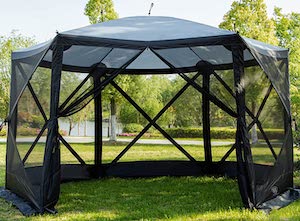
Dimensions: 11.5 x 10 (feet)
You can easily see why this spacious portable “screen room” makes my list. With six mesh panels in total, this design offers an incredible balance of isolation and ventilation when you want to relax in privacy at your campsite. It’s spacious enough to comfortably allow up to eight adults to lounge!
The real perk of this screen house tent is that it has an easy-up design that pops into place in just 3 minutes. I also really like that the attractive design makes it seem like you have a gazebo at your campsite. There’s also an ultra-durable carrying bag included that makes bringing this little slice of luxury along on your trip that much easier.
The waterproof design of this tent is so appreciated. The tent’s top cover is made of 200D waterproof polyester that offers 50+ UV protection. I love that you can nap in this tent in the middle of the afternoon without worrying about baking!
The way this tent sets up at your campsite is extremely secure. It comes with 19 stakes that work with six tie-down ropes. These stakes are really handy because the tent has a 26.7-pound build that definitely benefits from a little stabilization. The best part is that you’re getting all of this protection and privacy without giving up views of the beauty that surrounds you because the side mesh screens preserve your 360-degree views like magic!
Pros:
- Very attractive.
- Great mix of privacy and ventilation.
- UV protection.
- Waterproof top.
Cons:
- The size of this tent only makes it portable if you have a larger car.
- The design could be improved using heavier stakes.
2. Caddis Rapid Shelter 10′ x 10′

Dimensions: 120 x 120 (inches)
This ultra-simple canopy design combines steel poles with a polyester shelter for a very dependable experience. You’re getting a nice 100-square-foot coverage area with this one. The top is made of a flame-resistant, UV-protected material that uses double stitching for resiliency. The truss-style straight-leg frame provides nice structure and durability.
Getting this shelter up takes just a minute. The four inside straps that are included help to secure your fabric to the frame for some nice wind resistance. In fact, you can actually purchase some matching walls to create a more effective wind barrier if you’re looking to enhance this shelter.
Something I really like is that this design uses heavy-duty poles and stakes even though the frame is pretty lightweight. It also comes with a high-quality carrying bag for portability. That bag comes in really handy once you realize that this seemingly dainty shelter actually weighs 52 pounds.
Pros:
- Set up is so smooth.
- Tent is very attractive.
- Thoughtful, high-quality design.
- Performs great in wind.
Cons:
- Prone to some sagging in heavy rain.
- Would love to see this available in colors other than white and blue.
3. REI Co-op Screen House Shelter

Dimensions: 120 x 120 inches
This is an extremely handsome tent shelter that I like for “buggy” areas because you’re able to close yourself inside. The design features straight zipper openings on two sides for a solid seal. However, these zippers are very easy to navigate for quick entries and exits. The aluminum poles combined with the polyester taffeta top will really make you feel protected.
A neat trick that you’ll often see people do with this shelter at campsites is to position it over a picnic table. The no-see-um mesh doors and walls ensure that you can eat in peace without being disrupted by bugs. There’s also another anti-bug feature that I want to point out because it’s so rare among shelters. This design features a fabric perimeter around the base that keeps pests from crawling into your space.
It’s not just the design of this shelter that impresses. I’m also impressed by the attention to detail that has gone into creating an easy system for setting it up. Color coding makes it so easy to assemble your pole sleeves and side clips.
Life inside this shelter is pretty sweet. The interior is actually full of hidden compartments that allow you to keep essentials close at hand. In addition to organizational pockets that are built into your walls, this shelter also features door pockets for easy grabbing. You’re also getting six stakes to hold it all down. This 13-pound shelter is a breeze to carry with help from the storage bag that’s included.
Pros:
- Very secure, high-quality design.
- Keeps bugs out.
- Easy to set up.
- Lightweight.
Cons:
- A little too lightweight for high-wind conditions.
4. Wenzel Magnetic Screen House
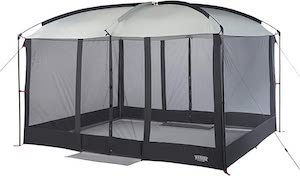
Dimensions: 11 x 9 (feet)
The big benefit with this screen house is that it features a magnetic design to “seal off” nature. It’s a top pick for buggy areas for this reason. The way it works is that magnetic strips line the doors to ensure automatic closure. The magnets are also neat because they allow you to do hands-free entry and exit.
This screen house’s design is also great for keeping you cool in the shade. The design is actually ideal for covering a picnic table at a campsite. What’s more, the 17-pound build ensures that lifting this house is easy! This shelter is made from a breathable polyester taffeta combined with 68D mesh. The structure is supported by ultra-light fiberglass and steel poles. A stuff sack that is included makes carrying this “lounge area on the go” to your campsite so simple!
Pros:
- Magnetic closure ensures that bugs stay out.
- You can carry food in and out easily with the hands-free entry and exit
- Lightweight design.
- Has built-in mud mats.
- The panels provide great views of your surroundings.
Cons:
- Roof material is on the thin side.
- Not the best in high-wind conditions.
5. MSR Rendezvous Sun Shield 200 Wing Shelter

This attention-grabbing shelter actually has irregular dimensions that provide 200 square feet of coverage. Expect for people to take note of this gorgeous shelter that defies convention. Of course, it’s the unconventional design of this shelter that allows it to provide so much coverage in a 6-pound body.
There’s a lot that I like about this shelter. First, it’s made of UPF 50+ fabric that shields you from UV rays. I also like the way this shelter stays so taut and stable in high winds with help from its unique seven-point design. There’s also the neat fact that you can actually make this shelter higher by purchasing some extra accessory poles. The seven stakes needed to get this shelter up are already included.
It’s a case of quality and ingenuity all around with this shelter. This is evident in the use of 68-denier ripstop polyester with aluminum poles. My big message with this shelter is to not be fooled by its delicate appearance. It’s a workhorse when it comes to keeping you shielded from sun, wind, and rain.
Pros:
- Lightweight.
- UV protection.
- Quality design and materials.
Cons:
- I’ve seen a few people comment that the guy lines are a little flimsy in relation to the rest of the design.
6. Coleman Instant Canopy
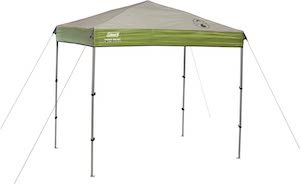
54.25 x 11.25 x 9 (inches)
This canopy is a more petite option than the others ones I’ve covered so far. Offering just 35 square feet of coverage, this design makes a great personal shelter. This one is even small enough to bring to the beach without being a “view blocker.”
I’m impressed that this canopy’s top is made with a UV-guard material that provides 50+ UPF protection. I’m also pretty delighted by the ultra-lightweight telescoping poles that are easy to manage. There’s also the very sweet perk that this canopy comes with its own wheeled carrying bag that makes transport and storage so breezy. On a personal note, I think the green-trimmed top is an attractive look that gives this canopy a very earthy look compared to some of the bright-colored canopies you usually see.
Pros:
- Lightweight.
- So easy to set up! It should take 3 minutes to get this ready to go.
- Comes with large, sturdy stakes.
- The cloth feels very thick and durable.
Cons:
- Not ideal in heavy rains because water can pool.
- Sand and dirt tend to get stuck in the height releases.
7. CAMPROS Screen House Room
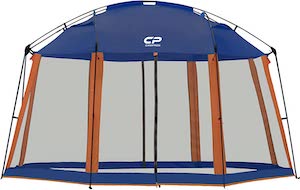
Dimensions: 156 x 156 x 86 (inches)
I’m a big fan of the “open concept” of this design because you truly get a good look at the nature scenes unfolding all around you without poles or fabric getting in the way. There’s a lot to like here aside from the open design. First, the 190T polyester used for the cover provides great UV resistance. The large zipper doors are also great for getting and out without issues.
One thing that I absolutely love is that the guy lines on this tent are reflective. I also really like the taller-than-average 86-inch center height. You’ll appreciate this if you’re on the taller side. It’s pretty impressive that you’re getting so much room from a 22.5-pound shelter.
This screen house comes with stakes, tie downs, and a carrying bag. Unlike some of the other shelters, this one doesn’t go up in seconds. You’ll probably need between three and four people to get the whole thing up in 10 minutes.
Pros:
- Spacious open concept is great for enjoying views.
- Large doors are appreciated.
- Tall center height is very appreciated.
- I love the reflective guy lines for visibility.
- Polyester material offers good UV resistance.
Cons:
- Take a little more effort to get up compared to other canopies.
8. Neso Grande Sunshade

Dimensions: 174 x 174 (inches)
This is another unconventional shelter that really turns heads at a campsite. It actually resembles a sail in my opinion. However, this shelter doesn’t just stand out because the design is unique. The whole concept beyond it is more than unique. The big difference here is that you’re not dealing with poles. First, I’ll cover what the construction looks like.
This sunshade is made from a four-way stretch nylon/Lycra® material with reinforced corners for durability. This material offers UPF 50+ sun protection, water repellency, and amazing tension. The design also features rustproof aluminum poles that collapse just like classic tent poles for easy carrying. However, what makes this sunshade remarkable is that you are meant to actually fill in the corners using natural resources like stones or sand to weigh it down. The 6-pound sunshade folds into you a nice carrying bag with a built-in cooler pocket.
Pros:
- Beautiful and unique design.
- Versatile enough for both woods and beach.
- Compact design.
- Impressive wind stability.
Cons:
- Sides are completely exposed.
- The poles seem like they stress somewhat easily.
9. CLAM Corporation 9879 Quick-Set Escape Shelter

Dimensions 150 x 150 x 94 (inches)
I like this shelter for those times when I want to savor coffee from my travel mug while chatting with good friends. The taped roof panel is great for keeping both water and bugs out. In addition, the shelter’s high-quality mesh screen with wide skirt is great for keeping out all types of insects. I’m impressed by the use of 210 denier poly oxford material.
Did I mention that this entire shelter takes just 45 seconds to set up? That’s because it’s a no-assembly canopy that’s ready to go right out of the box. You just have to secure your I-bolt pieces to secure the canopy externally. All stakes and ropes are included. There’s also a carrying bag that makes light work of lugging around this 32-pound canopy.
Pros:
- Good bug protection.
- Decent water resistant.
- Assembles in seconds.
- Sturdy.
Cons:
- Obscures your views a bit.
- A little bulky.
10. Yaheetech 10×10 Pop up Canopy Tent

Dimensions: 119 x 119 x 135 (inches)
This is a pretty classic “festival” tent. It actually works great as a social area, game area, or cooking area at a campsite. Using a construction that features 500D Oxford, PU, PVC, steel, plastic, and composite boards, this canopy tent is extremely durable and resilient. The 100% waterproof fabric offers UPF 50+ protection. You’re also getting four sandbags, four ropes, and four stakes to put it all together.
I really like that it comes with three holes that allow you to adjust the height simply based on the placement you choose on the tubular column. I have to point out that this 52-pound canopy is definitely on the heavier side. However, it’s meant to be kept up for a long period of time without worries. The wheeled carrying bag that’s provided certainly makes transporting this canopy easier. The high-quality bag actually comes with two castors, two feet, and two handles to ensure that you’re never struggling.
Pros:
- Sturdy enough for commercial use.
- Adjustable height.
- Waterproof.
- UPF protection.
- Comes with a heavy-duty wheeled carrying case.
Cons:
- Heavier than average.
- Full exposed sides.
My Final Canopy Thoughts
All of the canopies on my list really raise the roof in terms of quality and durability. However, my pick for the best camping canopy is ultimately the EVER ADVANCED Pop Up Gazebo Screen House Tent. Why do I love it? This canopy gives you the experience of bringing along a sunroom on your camping trip. I love the mix of views, privacy, and space this design brings.
In addition to being durable, this gazebo-style shelter is easy to set up. It also gets bonus points from me for using 200D waterproof polyester with 50+ UV protection. I also feel like this is the one to spring for because you’re getting so much space from a design that goes up in minutes with zero hassles.
I hope my roundup of great camping canopies for this season has given you some inspiration for finding the best canopy for camping. I think that every pick on my list offers a little something for every type of camping style out there. I can’t wait to hear how the right canopy helps you to kick up your relaxation levels quite a few notches on your next trip into nature.

Fueled by his own lifelong passion for the outdoors, Ryan is dedicated to sharing his knowledge to help others experience the life-changing beauty and majesty of nature. He enjoys planning expeditions throughout the United States. He also has a passion for finding gear and methods that enhance the experience of enjoying nature.
